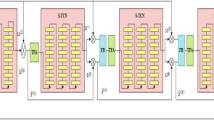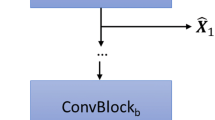Abstract
In general, the performance of deep learning based speech enhancement degrades in presence of unseen noisy environments for any signal-to-noise ratio (SNR) conditions. Although model adaptation techniques may help in improving the performance, they lead to catastrophic forgetting of the previously learned knowledge. Under such conditions, incremental learning or life-long learning has been reported to help in gradually learning the new tasks while maintaining the existing inferred knowledge. In this work, we propose a regularization-based incremental learning strategy for adapting temporal convolutional neural network (TCNN) based speech enhancement novel framework named as RIL-TCN. We investigate the effect of incorporating various weight regularization strategies such as curvature and path regularization on time-domain Scale-Invariant SNR (SI-SNR) loss function associated with TCNN based enhancement framework. We evaluate and compare the performance of our proposed model with the state-of-the-art frequency domain incremental learning model using objective measures such as SI-SNR and PESQ (Perceptual Evaluation of Speech Quality). We show that our proposed approach outperforms on unseen noises from standard CHiME-3 corpus compared to competitive TCNN baseline.
Access this chapter
Tax calculation will be finalised at checkout
Purchases are for personal use only
Similar content being viewed by others
References
Perceptual evaluation of speech quality (pesq): An objective method for end-to-end speech quality assessment of narrow-band telephone networks and speech codecs, rec. itu-t p. 86 (2001)
Barker, J., Marxer, R., Vincent, E., Watanabe, S.: The third ‘chime’ speech separation and recognition challenge: dataset, task and baselines. In: 2015 IEEE Workshop on Automatic Speech Recognition and Understanding (ASRU), pp. 504–511 (2015). https://doi.org/10.1109/ASRU.2015.7404837
Biswas, R., Nathwani, K., Abrol, V.: Transfer learning for speech intelligibility improvement in noisy environments. In: Proceedings of the Interspeech 2021, pp. 176–180 (2021). https://doi.org/10.21437/Interspeech.2021-150
Choy, M.C., Srinivasan, D., Cheu, R.L.: Neural networks for continuous online learning and control. IEEE Trans. Neural Networks 17(6), 1511–1531 (2006). https://doi.org/10.1109/TNN.2006.881710
Cohen, I.: Noise spectrum estimation in adverse environments: improved minima controlled recursive averaging. IEEE Trans. Speech Audio Process. 11(5), 466–475 (2003). https://doi.org/10.1109/TSA.2003.811544
Ephraim, Y., Malah, D.: Speech enhancement using a minimum-mean square error short-time spectral amplitude estimator. IEEE Trans. Acoust. Speech Signal Process. 32(6), 1109–1121 (1984). https://doi.org/10.1109/TASSP.1984.1164453
Fu, S.W., Tsao, Y., Lu, X., Kawai, H.: Raw waveform-based speech enhancement by fully convolutional networks. In: 2017 Asia-Pacific Signal and Information Processing Association Annual Summit and Conference (APSIPA ASC), pp. 006–012 (2017). https://doi.org/10.1109/APSIPA.2017.8281993
Gnanamanickam, J., Natarajan, Y., Sri Preethaa, K.R.: A hybrid speech enhancement algorithm for voice assistance application. Sensors (Basel) 21(21), 7025 (2021). https://doi.org/10.3390/s21217025
Goodfellow, I.J., Mirza, M., Da, X., Courville, A.C., Bengio, Y.: An empirical investigation of catastrophic forgeting in gradient-based neural networks. In: Bengio, Y., LeCun, Y. (eds.) 2nd International Conference on Learning Representations, ICLR 2014, Banff, AB, Canada, April 14–16, 2014, Conference Track Proceedings (2014). https://arxiv.org/abs/1312.6211
Jia, X., Li, D.: TFCN: temporal-frequential convolutional network for single-channel speech enhancement. arXiv (2022)
Kim, D., Han, H., Shin, H.K., Chung, S.W., Kang, H.G.: Phase continuity: Learning derivatives of phase spectrum for speech enhancement. In: ICASSP 2022–2022 IEEE International Conference on Acoustics, Speech and Signal Processing (ICASSP), pp. 6942–6946 (2022). https://doi.org/10.1109/ICASSP43922.2022.9746087
Kim, J.H., Yoo, J., Chun, S., Kim, A., Ha, J.W.: Multi-domain processing via hybrid denoising networks for speech enhancement. arXiv (2018)
Kingma, D.P., Ba, J.: Adam: a method for stochastic optimization. In: 3rd International Conference on Learning Representations, ICLR 2015, San Diego, CA, USA, May 7–9, 2015, Conference Track Proceedings (2015)., https://arxiv.org/abs/1412.6980
Kinoshita, K., Ochiai, T., Delcroix, M., Nakatani, T.: Improving noise robust automatic speech recognition with single-channel time-domain enhancement network. In: ICASSP 2020–2020 IEEE International Conference on Acoustics, Speech and Signal Processing (ICASSP), pp. 7009–7013 (2020). https://doi.org/10.1109/ICASSP40776.2020.9053266
Kirkpatrick, J., et al.: Overcoming catastrophic forgetting in neural networks. Proc. Natl. Acad. Sci. 114(13), 3521–3526 (2017). https://doi.org/10.1073/pnas.1611835114
Kishore, V., Tiwari, N., Paramasivam, P.: improved speech enhancement using TCN with multiple encoder-decoder layers. In: Proceedings of the Interspeech, 2020, pp. 4531–4535 (2020). https://doi.org/10.21437/Interspeech.2020-3122
Lee, C.C.: Seril (2020). https://github.com/ChangLee0903/SERIL
Lee, C.C., Lin, Y.C., Lin, H.T., Wang, H.M., Tsao, Y.: SERIL: noise adaptive speech enhancement using regularization-based incremental learning. In: Proceedings of the Interspeech 2020, pp. 2432–2436 (2020). https://doi.org/10.21437/Interspeech.2020-2213
Lei, P., Chen, M., Wang, J.: Speech enhancement for in-vehicle voice control systems using wavelet analysis and blind source separation. IET Intel. Transport Syst. 13(4), 693–702 (2019)
Li, Y., Chen, F., Sun, Z., Ji, J., Jia, W., Wang, Z.: A smart binaural hearing aid architecture leveraging a smartphone app with deep-learning speech enhancement. IEEE Access 8, 56798–56810 (2020). https://doi.org/10.1109/ACCESS.2020.2982212
Lu, X., Tsao, Y., Matsuda, S., Hori, C.: Speech enhancement based on deep denoising autoencoder. In: Proceedings of the Interspeech 2013, pp. 436–440 (2013). https://doi.org/10.21437/Interspeech.2013-130
Masana, M., Twardowski, B., van de Weijer, J.: On class orderings for incremental learning (2020)
Menéndez, M., Pardo, J., Pardo, L., Pardo, M.: The Jensen-Shannon divergence. J. Franklin Inst. 334(2), 307–318 (1997). https://doi.org/10.1016/S0016-0032(96)00063-4
Nair, G.G., Kumar, C.S.: Speech enhancement system for automatic speech recognition in automotive environment. In: 2021 12th International Conference on Computing Communication and Networking Technologies (ICCCNT), pp. 01–07 (2021). https://doi.org/10.1109/ICCCNT51525.2021.9579986
Paliwal, K., Wójcicki, K., Shannon, B.: The importance of phase in speech enhancement. Speech Commun. 53(4), 465–494 (2011). https://doi.org/10.1016/j.specom.2010.12.003
Panayotov, V., Chen, G., Povey, D., Khudanpur, S.: Librispeech: an ASR corpus based on public domain audio books. In: 2015 IEEE International Conference on Acoustics, Speech and Signal Processing (ICASSP), pp. 5206–5210 (2015). https://doi.org/10.1109/ICASSP.2015.7178964
Pandey, A., Wang, D.: A new framework for supervised speech enhancement in the time domain. In: Proceedings of the Interspeech 2018, pp. 1136–1140 (2018). https://doi.org/10.21437/Interspeech.2018-1223
Pandey, A., Wang, D.: TCNN: temporal convolutional neural network for real-time speech enhancement in the time domain. In: ICASSP 2019–2019 IEEE International Conference on Acoustics, Speech and Signal Processing (ICASSP), pp. 6875–6879 (2019). https://doi.org/10.1109/ICASSP.2019.8683634
Park, S.R., Lee, J.W.: A fully convolutional neural network for speech enhancement. In: Proceedings of the Interspeech 2017, pp. 1993–1997 (2017). https://doi.org/10.21437/Interspeech.2017-1465
Qian, K., Zhang, Y., Chang, S., Yang, X., Florêncio, D., Hasegawa-Johnson, M.: Speech enhancement using Bayesian Wavenet. In: Proceedings of the Interspeech 2017, pp. 2013–2017 (2017). https://doi.org/10.21437/Interspeech.2017-1672
Rangachari, S., Loizou, P.C.: A noise-estimation algorithm for highly non-stationary environments. Speech Commun. 48(2), 220–231 (2006). https://doi.org/10.1016/j.specom.2005.08.005
Sivaraman, A., Kim, M.: Efficient personalized speech enhancement through self-supervised learning. IEEE J. Sel. Topics Sig. Process. 16(6), 1342–1356 (2022). https://doi.org/10.1109/JSTSP.2022.3181782
Thiemann, J., Ito, N., Vincent, E.: The diverse environments multi-channel acoustic noise database (DEMAND): a database of multichannel environmental noise recordings. In: Proceedings of Meetings on Acoustics, vol. 19, no. 1, p. 035081 (2013). https://doi.org/10.1121/1.4799597
Wang, Y., Narayanan, A., Wang, D.: On training targets for supervised speech separation. IEEE/ACM Trans. Audio Speech Lang. Process. 22(12), 1849–1858 (2014). https://doi.org/10.1109/TASLP.2014.2352935
Yosinski, J., Clune, J., Bengio, Y., Lipson, H.: How transferable are features in deep neural networks? In: Proceedings of the 27th International Conference on Neural Information Processing Systems - Volume 2. p. 3320–3328 (2014)
Zenke, F., Poole, B., Ganguli, S.: Continual learning through synaptic intelligence. In: Proceedings of the 34th International Conference on Machine Learning, pp. 3987–3995 (2017)
Zezario, R.E., Fuh, C.S., Wang, H.M., Tsao, Y.: Speech enhancement with zero-shot model selection. In: 2021 29th European Signal Processing Conference (EUSIPCO), pp. 491–495 (2021). https://doi.org/10.23919/EUSIPCO54536.2021.9616163
Zhang, G., Yu, L., Wang, C., Wei, J.: Multi-scale temporal frequency convolutional network with axial attention for speech enhancement. In: ICASSP 2022–2022 IEEE International Conference on Acoustics, Speech and Signal Processing (ICASSP), pp. 9122–9126 (2022). https://doi.org/10.1109/ICASSP43922.2022.9746610
Author information
Authors and Affiliations
Corresponding author
Editor information
Editors and Affiliations
Rights and permissions
Copyright information
© 2023 The Author(s), under exclusive license to Springer Nature Switzerland AG
About this paper
Cite this paper
Sabu, K., Sharma, M., Tiwari, N., Shaik, M. (2023). Regularization Based Incremental Learning in TCNN for Robust Speech Enhancement Targeting Effective Human Machine Interaction. In: Karpov, A., Samudravijaya, K., Deepak, K.T., Hegde, R.M., Agrawal, S.S., Prasanna, S.R.M. (eds) Speech and Computer. SPECOM 2023. Lecture Notes in Computer Science(), vol 14338. Springer, Cham. https://doi.org/10.1007/978-3-031-48309-7_17
Download citation
DOI: https://doi.org/10.1007/978-3-031-48309-7_17
Published:
Publisher Name: Springer, Cham
Print ISBN: 978-3-031-48308-0
Online ISBN: 978-3-031-48309-7
eBook Packages: Computer ScienceComputer Science (R0)




